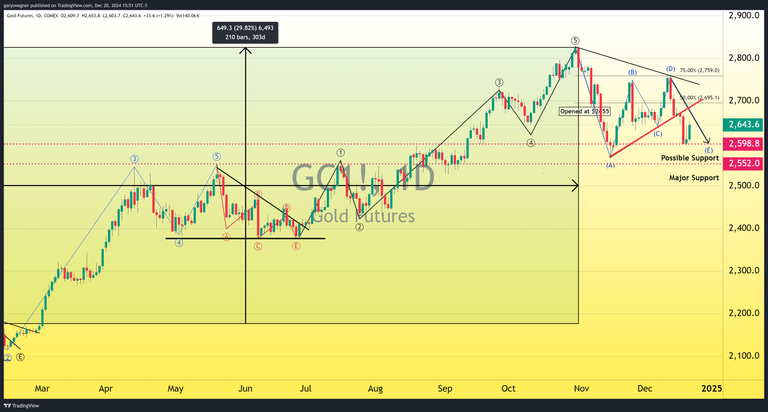
Gold futures stage recovery from $2600 support level, aided by dollar weakness
Gold futures demonstrated resilience this week, finding crucial support at the $2600 level after Wednesday’s close. The February contract, which opened at $2600.60 on Thursday, showed steady momentum throughout the session. Although Thursday’s gains were modest at just over $10, the price action around the psychologically significant $2600 mark suggested the formation of a technical support zone, marking a potential turning point after a challenging five-day selloff.
The precious metal’s performance received significant support from today’s dollar weakness, marking the first substantial decline in the U.S. currency since December 6, when the dollar index traded near 105. The dollar had previously shown remarkable strength, advancing in nine out of the past ten trading sessions to reach 108.473. Despite opening higher at 108.519 today, the index faced considerable selling pressure, declining 0.70% to 107.724.
The recent dollar strength primarily stemmed from the Federal Reserve’s latest Summary of Economic Projections (SEP) released Wednesday. While the Fed implemented the anticipated quarter-point rate cut, officials projected only a half-percent reduction in rates for the coming year, half the magnitude suggested in September’s projections.
The technical outlook for gold futures appears increasingly positive, with strong support emerging from the convergence of Wednesday’s closing and Thursday’s opening prices. Today’s session opened at $2609.70, slightly below Thursday’s close, before surging significantly higher. As of 4:30 PM ET, the February gold contract has gained $35.80, representing a 1.37% increase, to trade at $2645.90.

From a fundamental perspective, the looming threat of a government shutdown has bolstered gold’s appeal as a safe-haven asset. Congressional leaders are racing against time to formulate a comprehensive spending proposal, following the failure of earlier bipartisan efforts. The situation grew more complex after the House rejected a revised plan incorporating suggestions to extend the debt limit until January 31, 2027.
The potential consequences of failed negotiations include thousands of federal workers facing either unpaid work or furloughs. This scenario has become increasingly familiar over the past decade, with previous shutdowns often resolved at the last possible moment or, in worse cases, resulting in actual government closures. The most notable instance occurred during President Bill Clinton’s administration, resulting in a 21-day shutdown spanning 1995 and 1996.
For those who want more information on our premium service, please click the link Premium Service
Wishing you, as always good trading,
Disclaimer: The views expressed in this article are those of the author and may not reflect those of Kitco Metals Inc. The author has made every effort to ensure accuracy of information provided; however, neither Kitco Metals Inc. nor the author can guarantee such accuracy. This article is strictly for informational purposes only. It is not a solicitation to make any exchange in commodities, securities or other financial instruments. Kitco Metals Inc. and the author of this article do not accept culpability for losses and/ or damages arising from the use of this publication.




